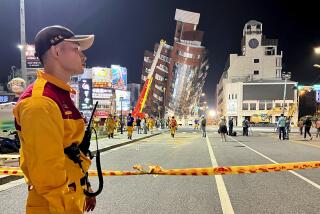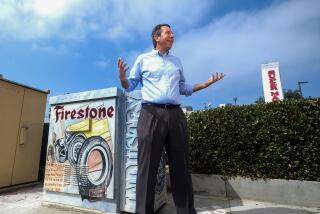Firm Tries to Chip Away at Semiconductor Waste
Bill Delaneyâs business model is simple: Garbage in, dollars out.
The computer industry veteran runs TecHarmonic Inc., a San Jose company that specializes in cleaning up the hazardous gases created in semiconductor manufacturing.
Contrary to the public picture of chip making -- technicians in white âbunnyâ suits working in pristine labs, churning out perfect copy after perfect copy of their microscopic wonders -- it is a highly polluting business whose byproducts include many noxious chemicals.
Gases known as perfluorocompounds, or PFCs, are widely used in semiconductor plants to etch the intricate circuitry on silicon wafers and as chemicals that are essential elsewhere in the fabrication process.
The gases are extremely stable and can persist for as long as 50,000 years. Despite their relatively small concentrations in our atmosphere -- especially compared with carbon dioxide, the âgreenhouse gasâ identified as the most significant cause of global warming -- they represent a growing worry to the industry and to environmentalists.
âThis is nasty stuff that weâre kicking out,â said Chief Executive Delaney, whose 20-employee business expects a tenfold annual increase in revenue to $10 million this year. âWe are dumping global warming gases into the atmosphere at an unprecedented rate. But while semiconductors are a small part of global warming, the effects last for so long.â
Of the entire volume of greenhouse gases released from all sources -- including cows and forest fires -- carbon dioxide accounts for about 85%, Delaney said.
PFCs -- which absorb and trap infrared radiation as heat and keep it in the atmosphere -- represent 0.1% of global warming gases. But their longevity and heat-trapping qualities amplify their damaging effects, said Shep Burton, an independent consultant to the Environmental Protection Agency on PFC emissions.
âThe issue is they stay around for such a long time -- the growth rate of PFCs is double digit,â said Burton, based in San Rafael, Calif., north of San Francisco. âIf 1 gram of PFCs is emitted, itâs equivalent to 1,000 grams of CO2.â
Recognizing the problem, the World Semiconductor Council, a consortium of trade groups, in 1999 committed to rolling back PFC gases produced by chip manufacturing to 10% below 1995 levels.
The industry started using less-stable PFCs that would decompose more easily and is beginning to adopt processes that donât use the compounds at all.
But such measures alone wonât get the industry to its goal, and that is where companies such as Delaneyâs come in.
TecHarmonic designs and sells machines to âcrackâ PFCs and other gases and render them into inert or treatable substances. Its products include dry-resin abatement systems to convert non-PFC gases into benign salts; so-called wet scrubbers that absorb water-soluble acid gases and route them to water-treatment facilities; and combination systems that break up PFC gases.
Delaneyâs task isnât easy -- and itâs not just the complex chemistry involved.
He is up against giants in the industry. The two big players are BOC Group of Britain, with $130 million to $150 million in annual revenue from abatement, and Applied Materials Inc., which takes in about $30 million in abatement revenue, according to industry estimates.
But TecHarmonic has won some big-name customers, namely French chip maker ST Microelectronics. The company -- with plants in France, Italy, Singapore and Phoenix -- accounts for about 40% of revenue.
Philips Semiconductors, a division of Netherlands-based Royal Philips Electronics, and large independent foundries in Asia also have bought TecHarmonic systems. Foundries make customized semiconductors for chip companies that donât have factories.
And in going against larger competitors, Delaney is banking on some in-house innovation that allows cracking of PFCs at lower temperature -- thus reducing cost and complexity.
Delaney, 60, a Southern California native, was student body president of Dominguez High School in Compton. He did his undergraduate work in metallurgical engineering at Purdue University and received a masterâs in mechanical engineering at UC Berkeley. Delaney worked for General Electric Co. in its nuclear power division, then in power delivery.
He joined semiconductor equipment manufacturer Applied Materials in 1980 and worked as director of international sales and services and then was transferred to Asia in 1984.
Delaney then became an agent for chip-making equipment in Asia, representing Applied Materials and other companies from 1987 to 2000.
During that time, he started to represent TecHarmonic, a small start-up that had been formed mainly by a South Korean and a Taiwanese backer. The first project it tackled was abatement equipment, and it has stayed with it ever since.
Delaney soon put in his own money and today is the major stakeholder in the company.
These days TecHarmonic is booming. Delaney predicts that revenue will grow to $30 million next year, $60 million in 2008 and $90 million in 2009.
He has caught the tide of the industry at a time when chip makers are investing in new equipment and processes. About 35 new wafer fabrication plants are scheduled to come on line around the world next year, adding about 20% capacity, said Burton, the EPA consultant.
âI donât know if he was prescient or lucky or what,â Burton said of Delaney, âbut heâs come at the right time.â
For his part, Delaney considers his career as coming full circle. âTo me, itâs like my fate is to clean up the mess made from the exhaust from the machines I sold for 15 years,â he said. âWeâre just an engineering company trying to do the right thing.â
More to Read
Inside the business of entertainment
The Wide Shot brings you news, analysis and insights on everything from streaming wars to production â and what it all means for the future.
You may occasionally receive promotional content from the Los Angeles Times.










